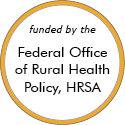Rural Project Examples: Population health
Promising Examples
School-Based Health Center Dental Outreach

Updated/reviewed July 2020
- Need: To improve the oral health status of children ages 3 to 17 living in underserved rural areas of Louisiana.
- Intervention: School-based nurse practitioners perform oral health assessments, apply fluoride varnishes when indicated, and make dental referrals, with completion rates of the latter tracked by dental case managers.
- Results: Significant numbers of school children are receiving oral health examinations, fluoride varnish applications, and receiving care coordination to improve numbers of completed dental appointments.
Prevention through Care Navigation Outreach Program

Updated/reviewed May 2020
- Need: To reduce the prevalence of diabetes and cardiovascular disease in rural Colorado.
- Intervention: Community Health Workers are utilized to create a system of coordinated care in Delta, Montrose, Ouray, and San Miguel counties.
- Results: As of 2018, 2,709 people have been screened for diabetes and cardiovascular disease, with many at-risk patients lowering cholesterol, blood pressure, and A1C levels after engaging with a Community Health Worker.
Youth4Health

Updated/reviewed December 2019
- Need: To educate youth about obesity and healthy lifestyle choices.
- Intervention: An educational program about healthy living was implemented in Lincoln and Claiborne Parishes in Louisiana for youth ages 9-18.
- Results: Youth4Health program produced greater awareness and participation in healthier lifestyles by target youth and their families, as well as church congregations.
Other Project Examples
AGRIMEDIC
Updated/reviewed February 2024
- Need: To reduce farm injuries and improve EMS and fire/rescue's response to these injuries in rural Louisiana and Mississippi.
- Intervention: AGRIMEDIC is a two-day training for first responders.
- Results: 810 first responders have received training.
Farm Assessment and Rehabilitation Methods (FARM) Program
Updated/reviewed February 2024
- Need: To help farmers with disabilities continue farming while protecting their well-being.
- Intervention: The FARM program helps disabled or ill farmers continue to operate and work their Wisconsin farms.
- Results: Since 2009, the FARM Program has helped over 3,500 farmers continue to farm, resume farming, or find an alternative agricultural occupation.
Coast to Forest: Mental Health Promotion in Rural Oregon and Beyond
Updated/reviewed January 2024
- Need: To promote mental health and prevent substance use disorders in rural Oregon, Washington, Idaho, and Alaska.
- Intervention: Coast to Forest strengthens local capacity through training, education, and community partnerships.
- Results: In its three years of operation, the project has trained over 500 individuals across the Pacific Northwest in Mental Health First Aid, developed 36 county-level resource guides, organized a series of Community Conversations in three rural Oregon counties, and more.
Mother's Milk Bank of South Carolina
Updated/reviewed January 2024
- Need: Neonatal Intensive Care Units (NICUs) across the state of South Carolina were purchasing breast milk from out-of-state milk banks for preterm infants.
- Intervention: The Mother's Milk Bank of South Carolina (MMBSC) opened 26 sites in South Carolina for breast milk to be donated, safely pasteurized, and delivered to NICUs across the state.
- Results: Over 19,178,739 ounces of milk have been donated to MMBSC depot sites and over 13,830,600 ounces of milk have been delivered to South Carolina NICUs.
University of Virginia Diabetes Tele-Education Program

Updated/reviewed January 2024
- Need: To educate people in rural Virginia who either have diabetes or are considered at high risk for developing it.
- Intervention: Teleconferencing technology is used to offer diabetes education programs to people with diabetes or those at high risk for developing it. Health professionals are also indirectly trained in diabetes care and management.
- Results: Participants reported better prevention practices and/or self-management of diabetes after being thoroughly educated about this condition.
Cold Water Safety Children and Youth Educator Program

Updated/reviewed December 2023
- Need: Drowning was a leading cause of death for children in Alaska.
- Intervention: Cold Water Safety and Survival for Educators workshops were developed in 1998, with help from a 4-year federal grant, to train educators to provide education and hands-on skills for school children and members of the public.
- Results: The safety program was integrated into about 50% of Alaskan school curriculum and schools in other states, helping to train hundreds of educators and thousands of children on the importance of cold water safety.
Rapid HCV Testing as an HIV Testing Strategy in Rural Areas
Updated/reviewed December 2023
- Need: To provide HIV testing in rural areas while navigating around HIV stigma.
- Intervention: A pilot study to provide HCV (Hepatitis C Virus) rapid tests and then offer an HIV rapid test as well.
- Results: An increase in the number of people tested for HCV and HIV.
For examples from other sources, see:
